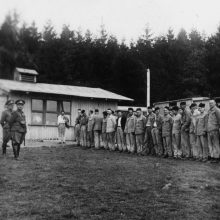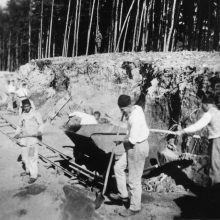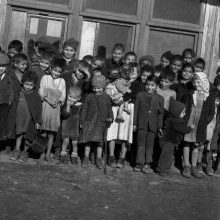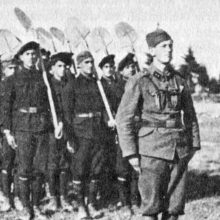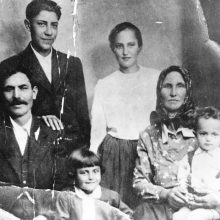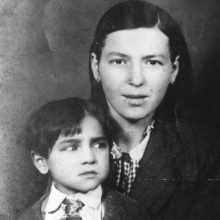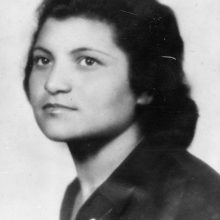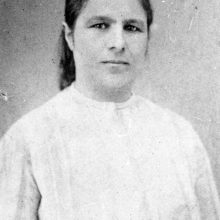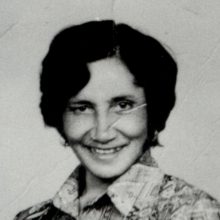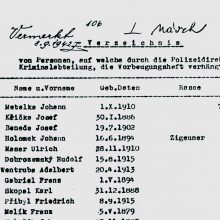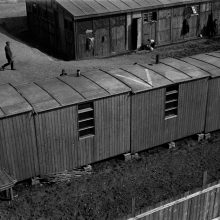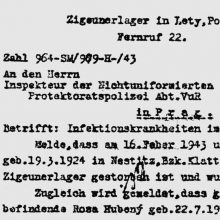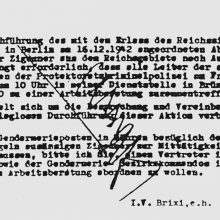Czechoslovakia
In March 1939 German troops occupied the Czech part of the country. Bohemia and Moravia were declared a German ‘protectorate’. Between August 1942 and spring 1943, 5,830 people in the ‘Protectorate of Bohemia and Moravia’ were officially registered as ‘gypsies’ and ‘gypsies of mixed blood’. At least 4,500 Sinti and Roma were deported to Auschwitz-Birkenau for extermination. Many of them had previously been interned at the Lety and Hodonín detention camps, where hundreds of prisoners fell victim to the atrocious conditions.
Czech gendarmes were responsible for guarding the ‘gypsy camps’ at Lety and Hodonín. While deportations to Auschwitz-Birkenau pursuant to Himmler’s order of 16 December 1942 were planned by the German Criminal Police, their implementation was in the hands of the Protectorate authorities and their gendarmerie.
The Roma were also persecuted in Slovakia, one of Hitler’s puppet states. Many were deported to camps or fell victim to the massacres carried out during the final phase of the war.
01 | The ‘gypsy camp’ at Hodonín, c. 1943 Národní Archiv Praha/Generální velitel neuniformované protektorátní policie (GVNP)
01
02 | The ‘gypsy camp’ at Lety, c. 1942 Výbor pro odškodnění romského holocaustu
02
03 | Roll call at the Lety camp, 1940 At this point the Roma accounted for only a small proportion of the inmates. It was only in 1942 that Lety and Hodonín were converted into special ‘gypsy camps’. Výbor pro odškodnění romského holocaustu
03
04 | Prisoners at the Lety camp carrying out forced labour, 1940 Výbor pro odškodnění romského holocaustu
04
05 | Children in Lety, c. 1942. Most of them were later deported to Auschwitz-Birkenau and murdered. Výbor pro odškodnění romského holocaustu
05
06 | Uniformed ‘Arbeitskompanie’ [‘fatigue company’] of Slovak Roma (propaganda photo from the Nazi magazine ‘Slowakische Rundschau’, early 1942). In January 1940, Slovakia, one of Hitler’s puppet states, passed military service legislation that excluded ‘Jews’ and ‘gypsies’ from military service in the regular Slovak army. Instead they were compelled to serve as a work corps […]
06
07 | Marie Ondrášová, also known as Kveta, was imprisoned at Lety aged 16. Her father, who had been active in the resistance, was arrested and later murdered; her sister survived the concentration camps at Auschwitz-Birkenau and Ravensbrück. Kveta later escaped from Lety and was able to remain in hiding until the end of the […]
07
08 | Members of the Kýra family before their deportation to Auschwitz-Birkenau. Of the original ten-member family, only three children survived the Holocaust. Museum of Romani Culture, Brno; photographer unknown
08
09 | Aloise Blumaierová (née Ištvánová in 1926) was deported from Hodonín to Auschwitz-Birkenau and from there to Ravensbrück for forced labour. Her father was murdered at Auschwitz-Birkenau; her brother, at Buchenwald. The photograph was taken shortly before her deportation to Auschwitz-Birkenau in 1943. Museum of Romani Culture, Brno; photographer unknown
09
10 | Emilie Hanáková (née Danielová) was deported to Auschwitz-Birkenau, where her husband and son were murdered. The family photo was taken in the 1920s. Museum of Romani Culture, Brno; photographer unknown
10
11 | Vlasta Danielová (née Kýrová) shortly before her deportation to Auschwitz-Birkenau in 1943, where her parents, her brother and two of her sisters were murdered. Museum of Romani Culture, Brno; photographer unknown
11
12 | Emilie Danielová (née Heráková) was deported from the Hodonín ‘gypsy camp’ to Auschwitz-Birkenau, where her parents, husband and two of her siblings were murdered. The photo shows her in 1946. Museum for Romani Culture, Brno, photographer unknown
12
13 | Růžena Danielová, here in a photo from the 1920s, survived the Auschwitz-Birkenau and Ravensbrück concentration camps. Her husband Martin Daniel and their five children were murdered in Auschwitz-Birkenau. She sang the song ‘Aušvicate hi kher báro’, which expresses the suffering of the Roma in Auschwitz-Birkenau. Museum of Romani Culture, Brno; photographer unknown
13
14 | The wedding of Magdalena Danielová, daughter of Růžena Danielová, just a few weeks before her deportation to Auschwitz-Birkenau. The date of death recorded in the camp register is 28 December 1943. Museum of Romani Culture, Brno; photographer unknown
14
15 | Adéla Reiskupová was deported from Hodonín to Auschwitz-Birkenau; she survived. The photo shows her in 1955. Museum of Romani Culture, Brno; photographer unknown
15
16 | Josef Serinek succeeded in escaping from the Lety ‘gypsy camp’ in September 1942 and joined a resistance organisation. The photograph, taken in Veselí in November 1944, shows Josef Serinek, Bachmuský and Šedý (from right to left). Museum of Romani Culture, Brno, photographer unknown
16
17 | Special supplement to the Polizeianzeiger for the ‘Protectorate of Bohemia and Moravia’ dated 23 July 1942 ‘Combating the gypsy nuisance’ Moravský zemský archiv, Brno
17
18 | Register of persons upon whom the Police Directorate in Brno imposed a so-called ‘preventive detention order’ (25 April 1942) ‘Registry of persons upon whom (…) a preventive detention order has been imposed’ Moravský zemský archives, Brno, B321 Proteorátní kriminální policie –Kriminální ředitelství Brno, box no. 27
18
19 | ‘Infectious diseases’ at the Lety camp, 17 February 1943 ‘Re: infectious diseases at the Lety gypsy camp’ Státní oblastní archiv v Třeboni
19
20 | Letter of the Protectorate Criminal Police/Brno Criminal Police Directorate dated 9 February 1943 ‘Removal of all gypsies from Moravia to a concentration camp’ United States Holocaust Memorial Museum
20

